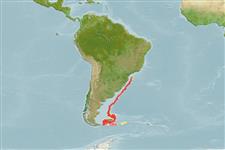Preferred temperature (Ref.
123201): 3.3 - 14.6, mean 4.6 °C (based on 47 cells).
Phylogenetic diversity index (Ref.
82804): PD
50 = 0.5000 [Uniqueness, from 0.5 = low to 2.0 = high].
Bayesian length-weight: a=0.00219 (0.00126 - 0.00381), b=3.16 (3.01 - 3.31), in cm total length, based on LWR estimates for this species & Genus-body shape (Ref.
93245).
Trophic level (Ref.
69278): 4.2 ±0.3 se; based on diet studies.
Resilience (Ref.
120179): Low, minimum population doubling time 4.5 - 14 years (Preliminary K or Fecundity.).
Fishing Vulnerability (Ref.
59153): Low to moderate vulnerability (28 of 100).
Climate Vulnerability (Ref.
125649): Low to moderate vulnerability (26 of 100).
Nutrients (Ref.
124155): Calcium = 21.3 [11.6, 49.8] mg/100g; Iron = 0.366 [0.166, 0.729] mg/100g; Protein = 15.7 [13.5, 18.1] %; Omega3 = 0.232 [0.104, 0.526] g/100g; Selenium = 18.5 [7.3, 44.3] μg/100g; VitaminA = 30.7 [6.4, 143.4] μg/100g; Zinc = 0.406 [0.264, 0.632] mg/100g (wet weight);
